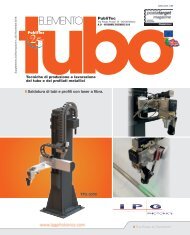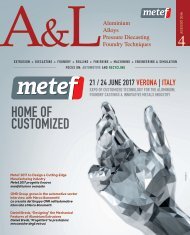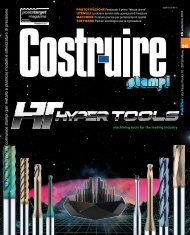Sfogliabile_AeL_n3_GIUGNO_2016
- No tags were found...
Create successful ePaper yourself
Turn your PDF publications into a flip-book with our unique Google optimized e-Paper software.
Foundry<br />
Figure 4:<br />
micro-graphic<br />
image of the<br />
section of a<br />
structural cast in<br />
an area in contact<br />
with the core<br />
Figura 4:<br />
micrografia di una<br />
sezione di un getto<br />
strutturale in una<br />
zona a contatto<br />
con l’anima<br />
Casts with better metallurgical properties<br />
The last advantage is the better metallurgical structure of casts<br />
in the areas that are in contact with the core. This aspect is determined<br />
by the behaviour of the core when it comes in contact<br />
with the liquid aluminium, since with an organic core the<br />
capablity of absorbing heat is gradually reduced during cooling.<br />
This phenomenon is shown by the graph in Figure 3, where<br />
the behaviour of the two cores is compared. The curves (left<br />
side) show how the organic core sand binder heats up instantly<br />
reaching a peak of roughly 480°C, a temperature where the<br />
capability of absorbing heat decreases. On the other hand the<br />
inorganic core absorbs much more heat in a longer time interval.<br />
The curve showing the speed at which the alloy solidifies<br />
confirms this trend: in the interval during which the liquid<br />
metalsolidifies,theinorganiccoresandbinderprovestobe<br />
still relatively cool, unlike the shell moulding core. The last consideration<br />
concerns the mould’s temperature: comparing the<br />
two graphics it can be seen that in the case of inorganic cores<br />
temperature is on average lower, a phenomenon that may still<br />
be associated to the high thermal capacity. The consequence<br />
isanincreaseofthespeedofcooling,thatcorrespondstoa<br />
veryfinesolidifyingmicro-structure,anindexofveryhigh<br />
mechanical performances. As an example, Figure 4 shows a<br />
micro-graphic rendering of the section of an EN-AC-42100<br />
structural cast obtained in an area in contact with the core. As<br />
may be observed, the micro-structure is particularly fine (average<br />
SDAS 23 µm); this implies high mechanical performanc-<br />
es. – Rp0.2=248MPa; Rm=305MPa; A%=12% – that may be compared<br />
to those in areas not in contact with the core.<br />
Limits to the application<br />
In consideration of the above statements, the use of inorganic<br />
core sand binders implies considerable advantages.<br />
There are, however, some limitations of this application: for<br />
instance the cores may not be emptied like shell moulding<br />
cores since the “lattice” of the binder forms on account of<br />
aflowofhotairina“gassing”processthatresemblesthe<br />
cold box method. The second disadvantage concerns the<br />
sand’s regeneration: today there are mechanical cycles of<br />
removalofthebinderfromthesandparticlesinsomepilot<br />
plants, whose efficiency still needs to be improved. The last<br />
aspect that should be taken into consideration is the drying<br />
of the cores after moulding as they have been proved<br />
to be sensitive to humidity, both in the sense of atmospherichumidityandofresidualhumidityduetothedryingprocess<br />
itself. The hot air introduced during the “gassing” process<br />
is meant to remove water completely form the mixture<br />
that serves as a solvent for the binder. Sometimes part of<br />
the water may however remain trapped in the core’s solid<br />
parts if correct process parameters are not used. Finally, in<br />
time residual humidity tends to migrate towards dry areas,<br />
makingthewholecoremorefragileForthisreasonstocking<br />
the cores in warehouses is also a critical issue , especially if<br />
temperature and atmospheric humidity are high. ❚<br />
I limiti d’applicazione<br />
Allalucediquantodettoinprecedenza,l’utilizzodelleanimeinorganicheportadeivantagginontrascurabili.Esistonoperòalcunilimitiapplicativi:adesempio,le<br />
animenonpossonoesseresvuotatecomequelleinshell<br />
moulding in quanto la “reticolazione” del legante avviene<br />
tramite passaggio di aria calda in<br />
un processo di “gasaggio” simile al<br />
cold box. Il secondo svantaggio è relativo<br />
alla rigenerazione della sabbia:adoggiesistonodeiciclimeccanici<br />
di rimozione del legante dalle<br />
particelle di sabbia in alcuni impianti<br />
pilota, la cui efficacia è ancora da<br />
migliorare. L’ultimo aspetto da tenere<br />
in considerazione è l’asciugatura<br />
delle anime dopo formatura in<br />
quanto risultano sensibili all’umidità,intesasiacomeumiditàatmosferica<br />
che come residuo del processo<br />
di asciugatura stesso. Infatti, l’aria<br />
calda introdotta durante la fase di<br />
“gasaggio”hailcompitodirimuovere<br />
completamente dall’impasto l’acquachefunge<br />
da solvente dellegante.<br />
Può però succedere che parte<br />
dell’acqua resti intrappolata nelle<br />
zone massicce dell’anima se non si<br />
utilizzano dei parametri di processocorretti.Infine,conilpassaredeltempol’umiditàresidua<br />
tende a migrare verso le zone asciutte, infragilendo<br />
l’intera anima.<br />
Per questo motivo risulta essere critica anche la stoccaggio<br />
a magazzino delle anime, soprattutto se le temperature<br />
e l’umidità atmosferica sono elevate. ❚<br />
76 -<br />
.com<br />
PubliTec





